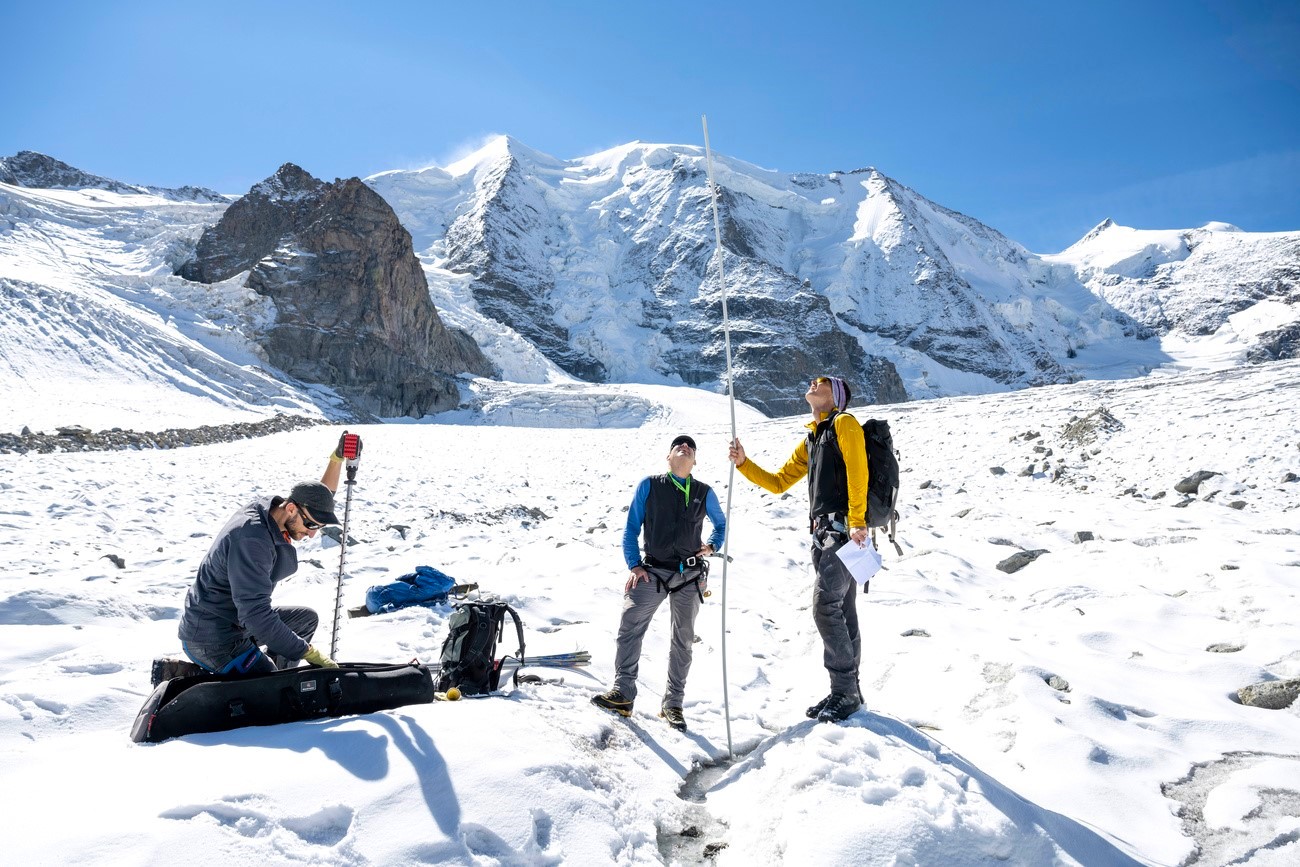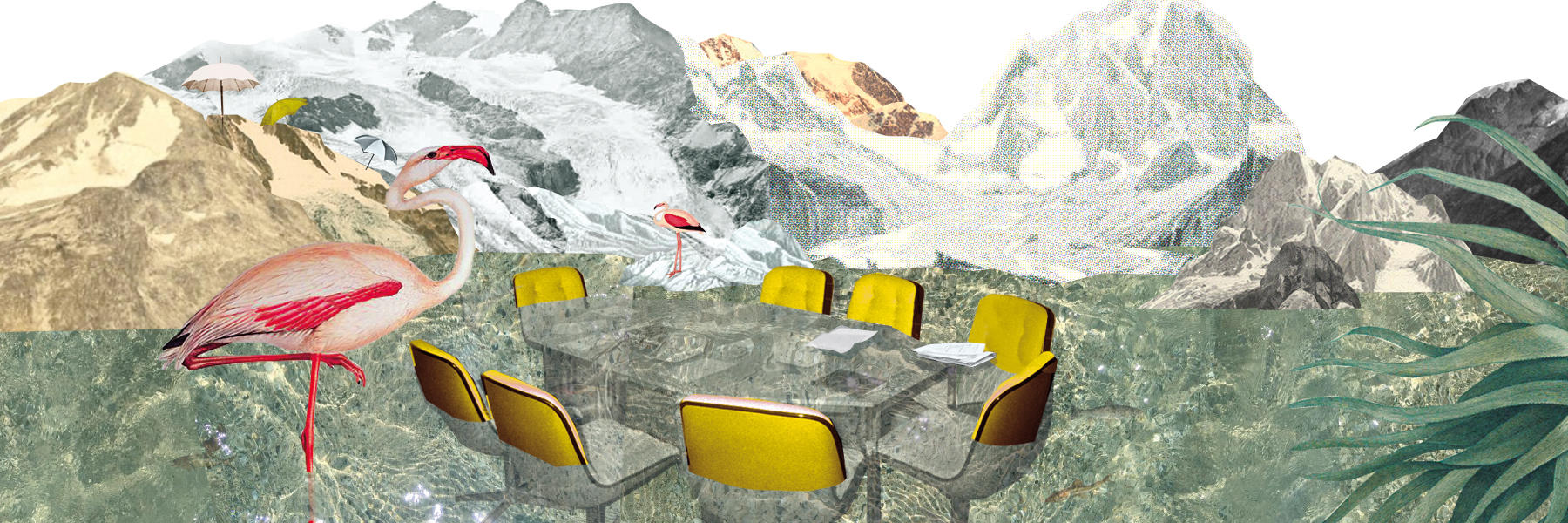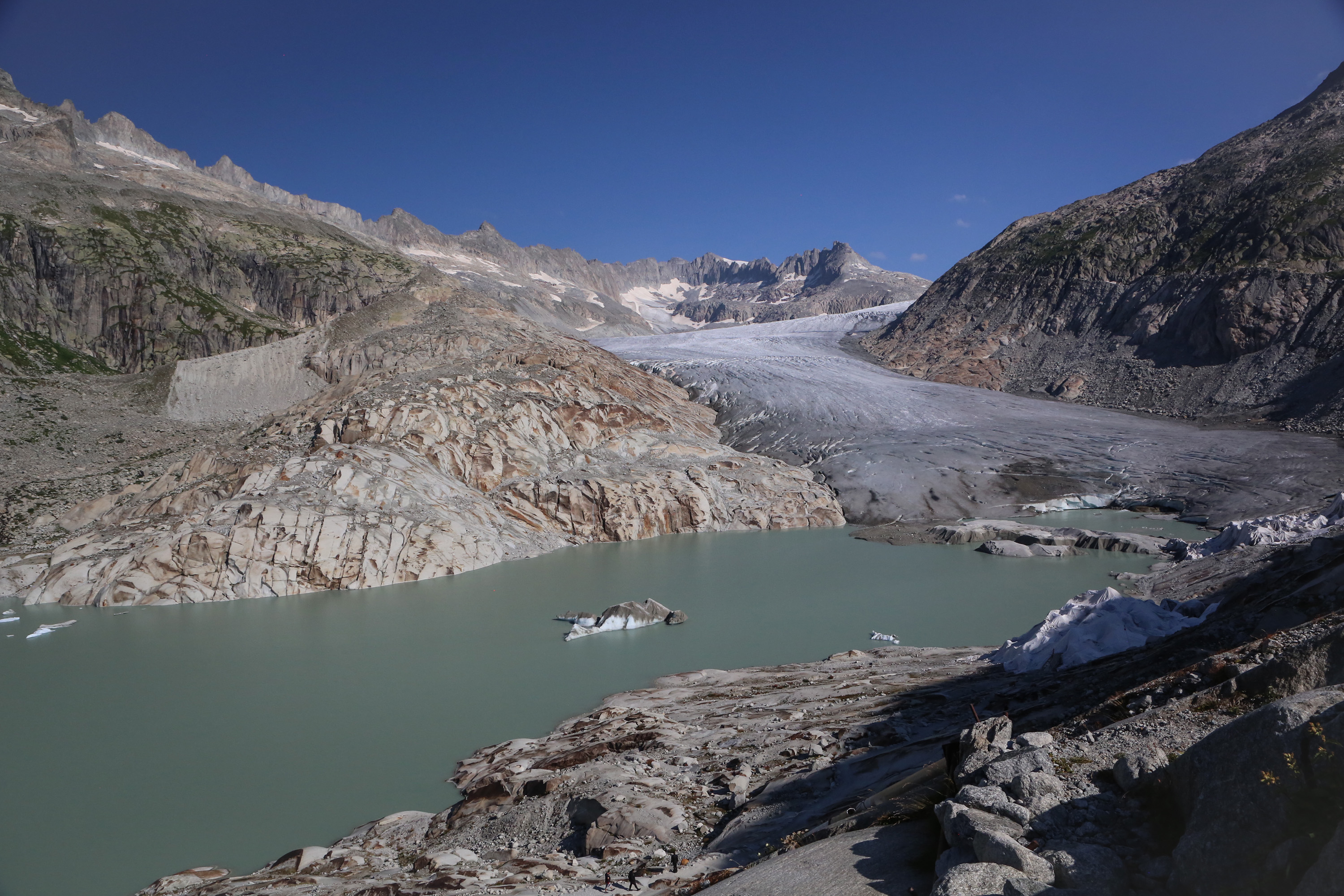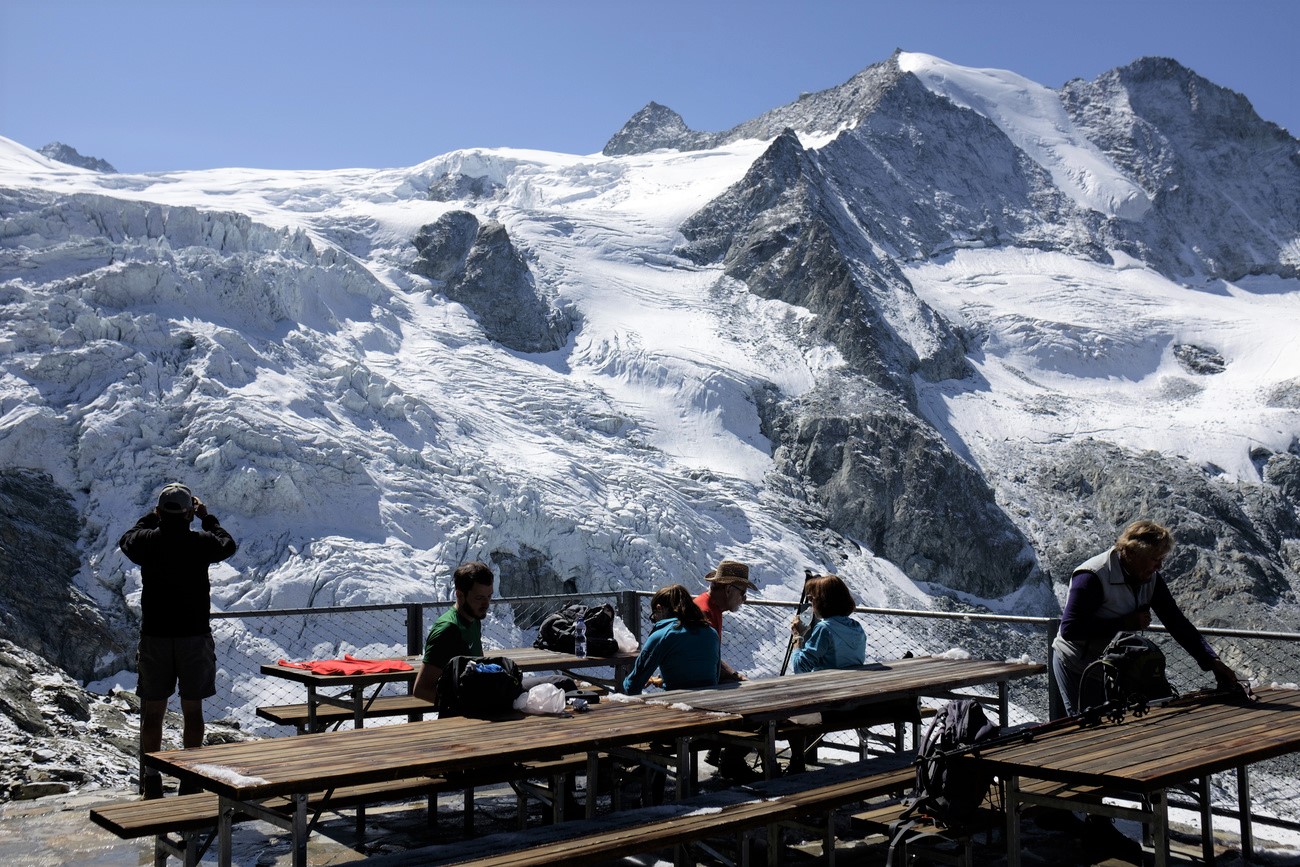
Why the Swiss are leading efforts to track melting glaciers

Glaciers all over the world, from the Alps to New Zealand, are rapidly melting. Switzerland plays a central role in monitoring them and the increasingly clear consequences of their disappearance. The first-ever World Glacier Day on March 21 is meant to bring awareness to this phenomenon which is happening in even the coldest regions on Earth.
“It is shocking to see how much ice is disappearing every year,” says Michael Zemp, a glaciologist at the University of Zurich and director of the World Glacier Monitoring Service (WGMSExternal link).
Last year, the world’s glaciers lost 450 billion tons (Gt) of ice, according to estimates released by the WGMS to mark World Glacier DayExternal link.
It’s less than was lost in 2023, but it was enough to make 2024 the fourth-worst year for glacier melt since 1975 and the third year in a row in which all the world’s regions experienced a net loss in glacier ice.
In the last 50 years, glaciers have lost enough ice to cover all of Germany in a layer 25 metres thick, according to Zemp.

Global water supply threatened by glacier melt
Glaciers provide fresh water to more than two billion peopleExternal link. They shape the landscape and contribute to the cultural identity of mountainous countries such as Switzerland or Bolivia. For scientists, they represent an invaluable source of data on climate evolution.
Their retreat due to global warming threatens the water supply of downstream communities, particularly in Asia and Latin America, and has negative repercussions for agriculture and hydropower generation. Melting glaciers increase the risk of landslides and floods and contribute to sea level rise.
World Glacier Day aims to raise awareness of the critical role of glaciers. It is one of the highlights of the International Year of Glaciers’ PreservationExternal link, a United Nations initiative to promote concrete actions to slow ice melt.
Among its goals is expanding global monitoring systems. Switzerland is a world leader in this area because of its long tradition of glaciological research. Glacier monitoring is essential for managing water resources and predicting the impacts of rising sea levels.
>> Melting glaciers affect everyone, even those who live thousands of miles away, as the following article explains:

More
Why melting glaciers affect us all
Ice is melting even in the coldest parts of the planet
Between 2000 and 2023, glaciers around the world (excluding continental glaciers in Greenland and Antarctica) lost more than 5% of their mass, according to a studyExternal link coordinated by WGMS and published in February. The melting has caused sea levels to rise by nearly 2 centimetres.
Glaciers in Switzerland and the European Alps have been hardest hit: they have lost 39% of their mass since 2000. Glaciers in the Caucasus, North Asia and the US have also experienced large losses. Melting has not spared glaciers in the polar regions either.
Until about 15 years ago there were areas, for example in Norway and New Zealand, where the ice mass was increasing, says Isabelle Gärtner-Roer of the WGMS in an interview with the Italian magazine Materia RinnovabileExternal link. For the past five to 10 years, however, there have been no regions with glacier growth.
“At the present melt rates, the ‘eternal ice’ in many regions will not survive the 21st century,” predicts Michael Zemp. In the Alps, more than 90% of glaciers could almost completely disappear before 2100External link.

Can glaciers be preserved?
Protective geotextiles to cover the ice and artificial snowmaking projects, such as the one on the MorteratschExternal link Glacier in Switzerland, can reduce melting on a local scale. However, these are expensive interventions with limited impact.
“The only way to preserve glaciers is to reduce greenhouse gases,” says Zemp.
Glaciers react to climate warming after a certain delay. Even if we zeroed emissions now, Zemp says, we would lose an additional 10-20% of glacier ice by 2050.
But human actions can determine what will happen in the second half of the century. The state of glaciers in 2100 will depend largely on the trajectory of emissions and on how much we continue to warm the planet. “Every tenth of a degree of warming avoided will save a portion of the glaciers,” Zemp says.
>> Melting glaciers can release microorganisms into the environment that are useful for developing new drugs. For the first time, a research team is looking for them in Swiss glaciers.

More
Secrets revealed by melting Swiss glaciers could eat plastic and cure disease
Monitoring the world’s glaciers for more than 130 years
Global information gathering on glaciers began in 1894 with the creation of the International Commission on Glaciers at a geology congress in Zurich. At that time, Switzerland already had a national glacier measurement network, and attendees at the congress decided to create a similar network for the entire world, explains Zemp.
The commission promoted collaboration among glaciologists around the world and helped form an international research network. Its work was limited to data collection and publication, however, and it was nearly a century before a more organised and centralised structure, the WGMS, was born.
Since 1986, the WGMS, based at the University of Zurich, has been gathering data on mass changes of a set of reference glaciersExternal link, for which there have been continuous measurements for more than 30 years. These glaciers represent different geographical regions and climatic conditions across the planet.
The monitoring service also collects information on a second set of glaciersExternal link. In total, it looks at more than 130 glaciers in some 30 countries, including about 20 in Switzerland.
“All collected data are freely accessible,” Zemp points out. Free sharing of information enables, among other things, the development of more efficient policies to address the climate crisis and adaptation strategies.
>> The Swiss glacier monitoring network GLAMOS is among the oldest and best performing in the world. Some glaciers are specially monitored, as this article explains:

More
Switzerland’s dangerous glaciers under close surveillance
How do you measure a glacier?
Glacier monitoring is based on a measurement of the amount of snow that accumulates on the surface of the glacier and the amount of ice that melts during the so-called hydrological year (October 1 to September 30).
The difference between accumulation and melt (or ablation), measured with graduated rods threaded into the glacier, is called the mass balance and gives an indication of glacier evolution. When ablation exceeds accumulation, for example following particularly hot summers, the mass balance is negative and the glacier retreats.
This method has the advantage of providing detailed and direct information about what is happening in glaciers, explains Enrico Mattea of the Department of Geosciences at the University of Fribourg in Switzerland. “Many monitoring techniques adopted worldwide have been developed in Switzerland, thanks to the accessibility of glaciers,” he points out.
These field measurements are the oldest and simplest method. However, they are only available for less than 1% of the planet’s more than 275,000 glaciers.

Such field analyses are complemented with data acquired with modern remote sensing systems. Satellites, aircraft, and more recently drones provide three-dimensional images of glaciers. Radar signals and laser beams sent from space make it possible to observe changes in the Earth’s surface and thus in the thickness of glaciers.
Another method, called gravimetry, measures the Earth’s gravitational field and allows an accurate assessment of a glacier’s mass. “Since 2000, we can measure glaciers, large and small, from all regions of the planet,” says Zemp.
>> The following video shows the advantages and limitations of the main glacier observation methods (from minute 00:40):
New reference glaciers
The recently released study of glacier changes between 2000 and 2023, coordinated by the WGMS, has made it possible to combine the best results from different field and satellite observation methods. This approach provides new insights into regional trends and annual glacier fluctuations and allows for improved future estimates of ice melt, sea level rise, and more, Zemp says.
Now, says Enrico Mattea, dozens of research institutes around the world will need to coordinate their measurements so that the surveys of different glaciers are homogeneous.
Scientists will also need to identify new reference glaciers since some of the traditional ones are disappearing due to global warming, Mattea says. For example, the Careser glacier in Italy could almost completely disappear by 2042External link.
There is no time to waste, and Zemp hopes that the Year of Glaciers will mark a turning point. Preserving glaciers means taking immediate and tangible action to reduce our greenhouse gas emissions, he says. “It would be great if 2025 will be remembered as the year in which humanity initiated this turnaround.”
Edited by Gabe Bullard and Veronica De Vore/sb

In compliance with the JTI standards
More: SWI swissinfo.ch certified by the Journalism Trust Initiative




























You can find an overview of ongoing debates with our journalists here . Please join us!
If you want to start a conversation about a topic raised in this article or want to report factual errors, email us at english@swissinfo.ch.